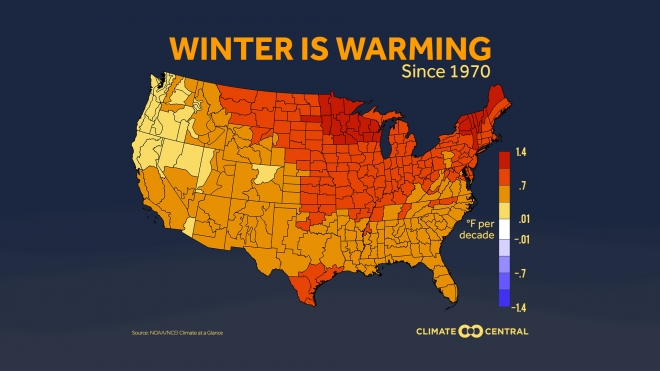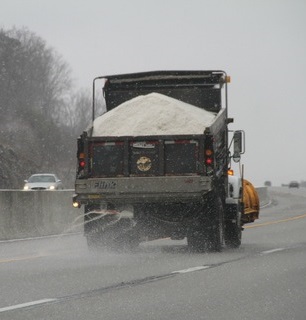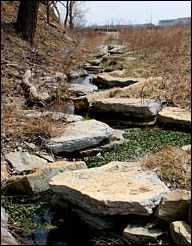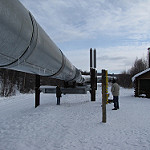|

Minnesota Winters Aren’t What They Used to Be
Minnesotans love to talk about weather. In recent years, winter brings a flurry of conversations about the shortage of frigid days and good old-fashioned snowstorms. While this week fulfilled some fundamentals of a Minnesota winter with plunging temperatures, wind-driven snow, and treacherous driving conditions, we started the week with record-breaking mild weather.
While it’s easy to speculate that Minnesota winters aren’t what they used to be, a recent report illustrates just how much temperatures are actually changing here. The report from nonprofit group Climate Central shows that winters are warming faster in the Great Lakes and Great Plains than anywhere else in the U.S. In parts of Minnesota, Wisconsin, and northern New England, winters have warmed at an average rate of more than 1 degree per decade since 1970. Mankato and Minneapolis ranked among the fastest warming cities with a 6 degree increase; Fargo is 5.9 degrees warmer and Duluth registered 5.8 degrees warmer.
Sean Sublette, a meteorologist with Climate Central, explained that the coldest places are warming the most because, “It takes less energy to warm something cold than it does to warm something already warm.” He added that’s why the Arctic and Antarctic areas are among the fastest warming on Earth.
In Minnesota, this warming has meant shorter seasons for snow and lake ice which has impacted businesses that depend on outdoor winter recreation. It means that pests like the Japanese beetle and emerald ash borer are more likely to survive winter, allowing for major attacks come summer. It’s also having an effect on birds’ migratory patterns and our state’s habitat and wildlife.
Warming trends are expected to continue, and the consequences are getting harder to ignore. While milder winters are appealing to some, climate change has increased catastrophic weather events across the country, including Minnesota. Please visit Climate Generation’s website for information on how you can take action on climate change.
 |
Road salt is polluting our water.
Here’s how we can fix it.
(From MPR) — Just a teaspoon of road salt pollutes 5 gallons of water — forever. And each winter, Minnesota dumps some 730 million pounds of salt on roadways. That’s probably far more salt than we need to keep our roads safe. Once snow melts, salt flows into lakes and streams. Once salt is in a body of water, it’s nearly impossible to remove. In fact, the only feasible way to clean up salt-contaminated water is through reverse osmosis, which remains too expensive to implement on a large scale.
>>Read More
|

|

Photo credit: National Park Service |
A MINER problem: Emmer mining bill passes House, but who will take it up in the Senate?
(From MinnPost) — The battle over mining in northern Minnesota — which has played out in Washington and Minnesota over the last year — reached a critical point in Congress last week. Eleven months after Barack Obama’s administration released an order that could block mining in a part of Superior National Forest for 20 years, the U.S. House of Representatives passed legislation, introduced by 6th District Republican Rep. Tom Emmer, to undo that decision, and to make it significantly harder for the executive branch to issue similar orders in the future.
>>Read More
|
 |
PUC rejects state’s environmental review for Enbridge’s Line 3 project
(From Star Tribune) — The state environmental review of Enbridge’s controversial new oil pipeline across northern Minnesota was rejected by utility regulators Thursday, though only on a few narrow concerns.The Minnesota Public Utilities Commission, by a vote of 4 to 1, deemed “inadequate” the Environmental Impact Statement (EIS) for Enbridge’s proposed new Line 3 pipeline. The EIS, conducted by the Minnesota Department of Commerce, looked at myriad potential environmental outcomes of a new pipeline but made no conclusions.
>>Read More
|
 |
Soil Power! The Dirty Way to a Green Planet
(From The New York Times) — The last great hope of avoiding catastrophic climate change may lie in a substance so commonplace that we typically ignore it or else walk all over it: the soil beneath our feet. The earth possesses five major pools of carbon. Of those pools, the atmosphere is already overloaded with the stuff; the oceans are turning acidic as they become saturated with it; the forests are diminishing; and underground fossil fuel reserves are being emptied. That leaves soil as the most likely repository for immense quantities of carbon.
>>Read More
|
Weekly Environmental Trivia – Answers Below Job Postings!
|
 |
1. What is Minnesota’s official state grain?
2. What are the names of the two U.S. National Forests in Minnesota?
3. What 60-mile-long land formation in southwest Minnesota features more than 200 wind turbines?
|
|
|